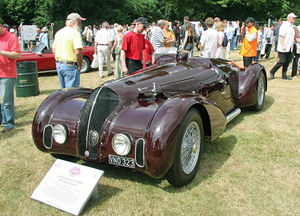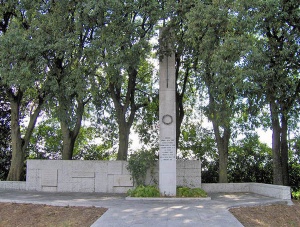Mille Miglia
The Mille Miglia (Thousand Miles) was an open-road endurance race which took place in Italy twenty-four times from 1927 to 1957 (thirteen before the war, eleven from 1947).
Like the older Targa Florio and later the Carrera Panamericana, the MM made Gran Turismo (Grand Touring) sports cars like Alfa Romeo, Ferrari (which debuted as a marque in the 1940 event), Maserati and also Porsche famous.
Car numbering
Unlike modern day rallying where cars are released at one minute intervals with the larger professional class cars going before the slower cars, in the Mille Miglia the smaller displacement slower cars started first. This made organisation simpler as marshalls did not have to be on duty for as long a period and it minimised the period that roads had to be closed. Cars were assigned numbers according to their start time. For example, the 1955 Moss/Jenkinson car, #722, left Brescia at 7:22 AM (see below), while the first cars had started at 9 PM the previous day. In the early days of the race even winners needed 16 hours or more, so most competitors had to start before midnight and arrived after dusk - if at all.

Before the war
The race was established by the young Contes Aymo Maggi and Franco Mazzotti, apparently in response to their home town of Brescia 'losing' the Italian Grand Prix to Monza. Together with a group of wealthy associates, they chose a race from Brescia to Rome and back, a figure-eight shaped course of roughly 1500 km - or a thousand Roman miles. Later races followed twelve other routes with varying total lengths.
The first race started on 26 March 1927 with around seventy-five starters - all Italian. The winner completed the course in just under 21 hours 5 minutes; local marque OM swept the top three places.
Similar to modern day rallying, cars were started one by one, every minute. As number, the starting time was painted on the cars, as an easy indication of performance. As even winners needed 16 hours or more at the time, most competitors had to start before midnight and arrived after dawn - if at all.
One of the most remarkable events in racing history was recorded at the 1930 MM. After the legendary Tazio Nuvolari passed several other contenders and caught up to the last remaining challenger in front, he turned off his headlights at Peschiera and followed Achille Varzi's tail lamps. Nuvolari would (miraculously) survive, and win.
The event was usually dominated by local Italian drivers and marques, but 3 races were won by foreign cars, all of them German. In 1931, Rudolf Caracciola (famous in Grand Prix racing) and onboard mechanic Wilhelm Sebastian won with their big supercharged Mercedes-Benz SSK. It was also the first of 3 wins for a foreign driver as Caracciola was German, despite his name. The win was a surprise as Caracciola had received very little support from the factory due to the economic crisis at that time. He did not have enough mechanics to man all necessary service points. After performing a pit stop, they had to hurry across Italy, cutting the triangle-shaped course short in order to arrive in time before the race car.
The race was briefly stopped by Mussolini after an accident in 1938 killed a number of spectators. When it resumed in 1940 during war time, it was dubbed the Grand Prix of Brescia, and held on a 100km short course in the plains of Northern Italy that was lapped 9 times. This event saw the debut of the Ferrari marque (with the Tipo 815). Despite being populated (due to the circumstances even more than usual) mainly by Italian makers, it was the aerodynamically improved BMW 328 driven by Germans Huschke von Hanstein/Walter Baumer that won the high-speed race at an all-time high average of 166 km/h.
Post-war
The Italians continued to dominate their race after the war, now again on a single big lap through Italy. Mercedes made another good effort in 1952 with the underpowered original Mercedes-Benz 300 SL Gullwing, scoring second with the German crew Karl Kling/Hans Klenk that later in the year would win the Carrera Panamericana. Caracciola, in a comeback attempt, crashed.
Few other non-Italians managed podium finishes in the 1950s, among them Juan Manuel Fangio, Peter Collins and Wolfgang von Trips. In 1955, Mercedes made another attempt at winning the MM, this time with careful preparation and a more powerful car, the Mercedes-Benz 300 SLR which was based on the Formula One car (Mercedes-Benz W196), not the other sports cars named Mercedes-Benz 300SL. Both young German Hans Herrmann (who had a remarkable previous efforts with Porsche) as well as British Stirling Moss relied on the support of navigators while Juan Manuel Fangio (car #658) preferred to drive alone as usual as he considered road races dangerous since his co-pilot was killed in South America. Karl Kling also drove alone, in the fourth Mercedes, #701.
Similar to his teammates, Moss and his navigator, motor race journalist Denis Jenkinson, ran a total of six reconnaissance laps beforehand, enabling "Jenks" to make course notes (pace notes) on a scroll of paper 15 feet long that he read from and gave directions to Moss during the race by a coded system of hand signals. Although this undoubtedly helped them, Moss's innate ability was clearly the predominant factor. Indeed, it should be noted that Moss was competing against drivers with a large amount of local knowledge of the route, so the reconnaissance laps were considered an equaliser, rather than an advantage.
Car #704 with Hans Herrmann and Hermann Eger was said to be fastest in the early stages, though. Herrmann already had a remarkable race in 1954, when the gate on a railroad crossing were lowered in the last moment before the fast train to Rome passed. Driving a very low Porsche 550 Spyder, Herrmann decided it was too late for a brake attempt anyway, knocked on the back of the helmet of his navigator Herbert Linge to make him duck, and they barely passed below the gates and before the train, to the surprise of the spectators. Herrmann was less lucky in 1955 as he had to abandon the race after a brake failure. Kling crashed also.
After 10h07'48", Moss/Jenkinson arrived in Brescia in their Mercedes-Benz 300 SLR with the now famous #722, setting the event record at an average of 159,65 km/h which was fastest ever on this 1597km variant of the course, not to be beaten in the remaining two years. Fangio arrived a few minutes later in the #658 car, but having started 24min earlier, it actually took him about 30 minutes longer.
The end
The race was banned after a fatal crash in 1957 that took the lives of driver Alfonso de Portago, his co-driver/navigator Edmund Nelson, and eleven spectators, at the village of Guidizzolo. The crash was probably caused by a blown tire. The manufacturer was blamed and sued for this, as was the Ferrari team, which, in order to save time, had not changed tires.
From 1958 to 1961, the event resumed as a Rallying-like round trip at legal speeds with a few special stages driven at full speed, but this was discontinued also.
Since 1977, the name was revived as the Mille Miglia Storica, a parade for pre-1957 cars that takes several days, which also spawned the 2007 documentary film Mille Miglia - The Spirit of a Legend.
Mille Miglia winners
Name usage
Mille Miglia is also the name of Alitalia's frequent flyer program.
Mille Miglia is also the name of a jacket, named after the race, inspired by the 1920's racewear and designed by Massimo Osti for his CP Company clothing label. The garment features goggles built into the hood and originally also had a small circular window in the sleeve enabling the wearer to see their watch. The jackets have been for a long period and are still popular with British football casuals.
As a sponsor and timekeeper of the Storica event, the event have lent its name and its trademark logo to Chopard for a series of sport watches. Also for promotions, shots from the event is used.
The Mille Miglia today
In 1982 the Mille Miglia endurance race was revived as a road rally event. Nowadays,timing rather than speed is of the essence for the enthusiasts from around the world who race their vintage cars, dating from 1927 to 1957. This magnificent parade of classic machines has earned the Mille Miglia the reputation of being the "the most beautiful road race in the world". Every May, Brescia becomes the meeting place for the rich, famous and passionate as they prepare to do battle over 1,600 miles of Italian roads. The event is closely followed by the press and immortalized every year by one of world's most respected photographers, Giacomo Bretzel, whose images so perfectly communicate the intensity, the emotion and the spirit of the moment. The history of the Mille Miglia is traced in all its glory, from yesteryear to the present day, at the Mille Miglia Museum, Brescia. This collection is a must for all amateurs of the automobile and its history and includes a fine collection of books and photographic works.
Mille Miglia Storica results


- 1977 : Hepp / Bauer - Alfa Romeo RLSS - 1927
- 1982 : Bacchi / Montanari - O.S.C.A MT 4 - 1956
- 1984 : Palazzani / Campana - Stanguellini 1100 S - 1947
- 1986 : Schildbach / Netzer - Mercedes-Benz SSK - 1929
- 1987 : Nannini / Marin - Maserati 200 SI - 1957
- 1988 : Rollino / Gaslini - Fiat 1100 S MM - 1948
- 1989 : Valseriati / Favero - Mercedes-Benz 300 SL - 1955
- 1990 : Agnelli / Cavallari - Cisitalia 202 SC - 1950
- 1991 : Panizza / Pisanelli - Renault 750 Sport - 1954
- 1992 :
 Canè / Galliani - BMW 507 - 1957
Canè / Galliani - BMW 507 - 1957 - 1993 : Vesco / Bocelli - Cisitalia 202 SC - 1948
- 1994 :
 Canè / Galliani - Lancia Aurelia B 20 - 1957
Canè / Galliani - Lancia Aurelia B 20 - 1957 - 1995 : Ferrari / Salza - Abarth 750 Zagato - 1957
- 1996 :
 Canè / Galliani - BMW 328 MM - 1937
Canè / Galliani - BMW 328 MM - 1937 - 1997 : Valseriati / Sabbadini - Mercedes-Benz 300 SL Pr - 1952
- 1998 :
 Canè / Galliani - BMW 328 MM - 1937
Canè / Galliani - BMW 328 MM - 1937 - 1999 :
 Canè / Auteri - Ferrari 340 MM - 1953
Canè / Auteri - Ferrari 340 MM - 1953 - 2000 :
 Canè / Galliani - BMW 328 MM - 1937
Canè / Galliani - BMW 328 MM - 1937 - 2001 : Sisti / Bernini - Healey Silverstone - 1950
- 2002 :
 Canè / Galliani - BMW 328 Touring - 1940
Canè / Galliani - BMW 328 Touring - 1940 - 2003 :
 Sielecki / Hervas - Bugatti T 23 Brescia - 1923
Sielecki / Hervas - Bugatti T 23 Brescia - 1923 - 2004 :
 Canè / Galliani - BMW 328 MM Coupè
Canè / Galliani - BMW 328 MM Coupè - 2005 :
 Viaro / De Marco - Alfa Romeo 6C 1500 S - 1928
Viaro / De Marco - Alfa Romeo 6C 1500 S - 1928 - 2006 :
 Canè / Galliani - BMW 328 MM Coupè
Canè / Galliani - BMW 328 MM Coupè - 2007 :
 Viaro / Bergamaschi - Alfa Romeo 6C 1500 S - 1928
Viaro / Bergamaschi - Alfa Romeo 6C 1500 S - 1928 - 2008 :
 Luciano and Antonio Viaro - Alfa Romeo 6C 1500 Super Sport - 1928
Luciano and Antonio Viaro - Alfa Romeo 6C 1500 Super Sport - 1928
See also
List of major automobile races in Italy
External links
- Grand Prix History, Mille Miglia
- http://www.1000miglia.eu/

